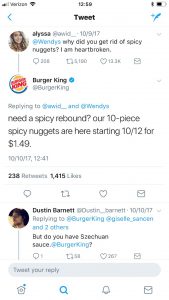As a self-diagnosed social media addict, it should come as no surprise that I was scrolling through my Twitter feed for the 100th time the other day when I stumbled upon a tweet from a user I didn’t recognize. The user’s name was Alyssa, and she had taken to Twitter to gripe about Wendy’s removing its beloved spicy chicken nuggets from its menu.

My first thought was: You know what, Twitter? I’m not in the market for chicken nuggets right now. You don’t know my life, and you’re not my real dad!
And my second thought was: This tweet is unrelated to both politics and celebrity gossip. Egads! This must be an ad for Wendy’s!

Sure enough, below Alyssa’s nugget-less lament was emblazoned the stamp of branded content. But the ad wasn’t coming from Wendy’s. No, dear reader, the tweet’s ad disclosure read “Promoted by Burger King.”

Wait – what?
Putting on my “digital communications professional who works with paid content and social media advertising” cap, I scrolled deeper into the comments. It was there that the pieces of the puzzle came together: a plug for Burger’s King’s newest product offering: 10-piece spicy chicken nuggets.

That’s right. The genius marketing team at Burger King dug through Wendy’s’ Twitter timeline and came back with receipts that customers were longing for bite-sized portions of peppered poultry. Leveraging a competitor’s negative customer feedback is some next-level shade that’s typically reserved for the likes of Taylor Swift, but Burger King pulled it off. It was simultaneously hilarious and on-brand, always a winning combo. Plus, their sneaky campaign succeeded where most fail, sparking interest that gets customers to engage – and retweet!

Wendy’s red wig has been officially snatched. And Burger King is the new fast food king*.
*Except for McDonald’s. Don’t @ me.
Looking to add a digital communications strategy to your business plan? We can help! Drop us a line at resteasy@devinestage.wpengine.com.
We are Devine + Partners. Communications and content experts who specialize in public relations, issues management (crisis communications), digital communications and content management.


